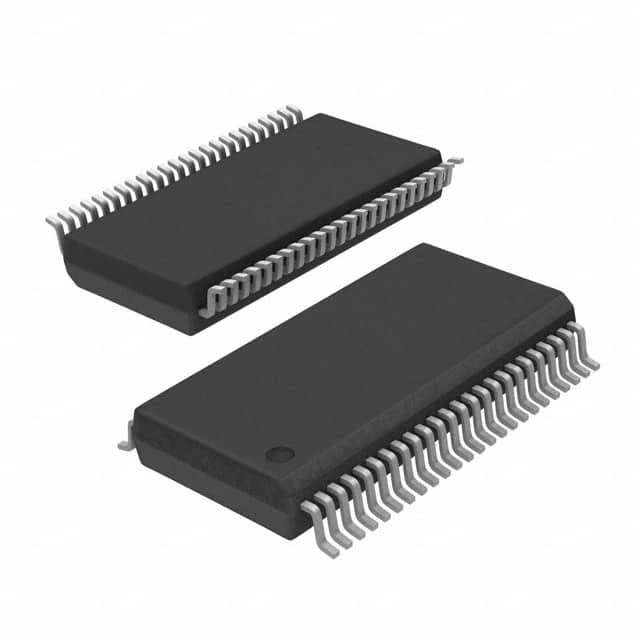Xem thông số kỹ thuật để biết chi tiết sản phẩm.

Encyclopedia Entry: 74VCXH162245TTR
Product Information Overview
- Category: Integrated Circuit (IC)
- Use: Logic Level Shifter
- Characteristics: High-speed, low-voltage, bidirectional level shifting
- Package: TSSOP (Thin Shrink Small Outline Package)
- Essence: Transceiver
- Packaging/Quantity: Tape and Reel, 2500 units per reel
Specifications
- Logic Family: VCXH
- Number of Channels: 16
- Voltage Level Translation: 1.2V to 3.6V
- Input Voltage Range (VCC): -0.5V to 4.6V
- Output Voltage Range (VCC): -0.5V to 4.6V
- Propagation Delay: 2.5 ns (typical)
- Operating Temperature Range: -40°C to +85°C
Detailed Pin Configuration
The 74VCXH162245TTR has a total of 48 pins, arranged in a TSSOP package. The pin configuration is as follows:
A1 ──────────────── B1
A2 ──────────────── B2
A3 ──────────────── B3
. . .
. . .
. . .
A24 ──────────────── B24
GND ──────────────── VCC
OE ──────────────── DIR
Functional Features
- Bidirectional voltage level shifting between two logic families
- Supports high-speed data transmission
- Low power consumption
- Wide operating voltage range
- ESD (Electrostatic Discharge) protection on all pins
- Output enable (OE) pin for disabling the outputs
- Direction control (DIR) pin for selecting the direction of data flow
Advantages and Disadvantages
Advantages: - High-speed operation allows for efficient data transfer - Wide operating voltage range enables compatibility with various logic families - ESD protection ensures robustness against electrostatic discharge - Output enable and direction control pins provide flexibility in controlling data flow
Disadvantages: - Limited to 16 channels, may not be suitable for applications requiring a higher number of channels - TSSOP package may require careful handling during assembly due to its small size
Working Principles
The 74VCXH162245TTR is a bidirectional level shifter that allows for voltage translation between two logic families. It operates by receiving input signals from one logic family and translating them to the appropriate voltage levels for the other logic family. The direction of data flow is controlled by the DIR pin. When the DIR pin is set to a specific logic level, the data is transmitted in that direction.
Detailed Application Field Plans
The 74VCXH162245TTR is commonly used in various applications where voltage level shifting is required between different logic families. Some of the typical application fields include:
- Microcontroller interfacing with different peripheral devices
- Communication interfaces such as UART, SPI, and I2C
- Memory modules and storage devices
- Industrial automation systems
- Automotive electronics
Detailed and Complete Alternative Models
- SN74LVC245A: Octal Bus Transceiver with 3-State Outputs
- MC74VHC245: Octal Bus Transceiver with 3-State Outputs
- CD74HCT245: Octal Bus Transceiver with 3-State Outputs
- 74LVC16245A: 16-Bit Bus Transceiver with 3-State Outputs
- SN74LVCH16245A: 16-Bit Bus Transceiver with 3-State Outputs
These alternative models offer similar functionality and can be considered as alternatives to the 74VCXH162245TTR based on specific requirements and availability.
Word count: 452 words
Liệt kê 10 câu hỏi và câu trả lời thường gặp liên quan đến ứng dụng 74VCXH162245TTR trong giải pháp kỹ thuật
Sure! Here are 10 common questions and answers related to the application of 74VCXH162245TTR in technical solutions:
Q: What is the 74VCXH162245TTR? A: The 74VCXH162245TTR is a high-speed, low-voltage, 16-bit bus transceiver with 3-state outputs.
Q: What is the voltage range supported by the 74VCXH162245TTR? A: The 74VCXH162245TTR supports a voltage range of 1.65V to 3.6V.
Q: What is the maximum data transfer rate of the 74VCXH162245TTR? A: The 74VCXH162245TTR has a maximum data transfer rate of 400 Mbps.
Q: Can the 74VCXH162245TTR be used for bidirectional data communication? A: Yes, the 74VCXH162245TTR can be used for bidirectional data communication as it has separate input and output ports.
Q: How many channels does the 74VCXH162245TTR have? A: The 74VCXH162245TTR has 16 channels, allowing it to handle 16 bits of data simultaneously.
Q: What is the purpose of the 3-state outputs in the 74VCXH162245TTR? A: The 3-state outputs allow the device to disconnect from the bus, effectively putting it in a high-impedance state.
Q: Can the 74VCXH162245TTR be cascaded to increase the number of channels? A: Yes, multiple 74VCXH162245TTR devices can be cascaded to increase the number of channels in a system.
Q: What is the power supply voltage required for the 74VCXH162245TTR? A: The 74VCXH162245TTR requires a power supply voltage of 1.65V to 3.6V.
Q: Is the 74VCXH162245TTR compatible with other logic families? A: Yes, the 74VCXH162245TTR is compatible with various logic families such as TTL, CMOS, and LVCMOS.
Q: What are some typical applications of the 74VCXH162245TTR? A: The 74VCXH162245TTR is commonly used in applications like data communication systems, memory interfaces, and general-purpose bus transceivers.
Please note that these answers are general and may vary depending on specific use cases and requirements.

